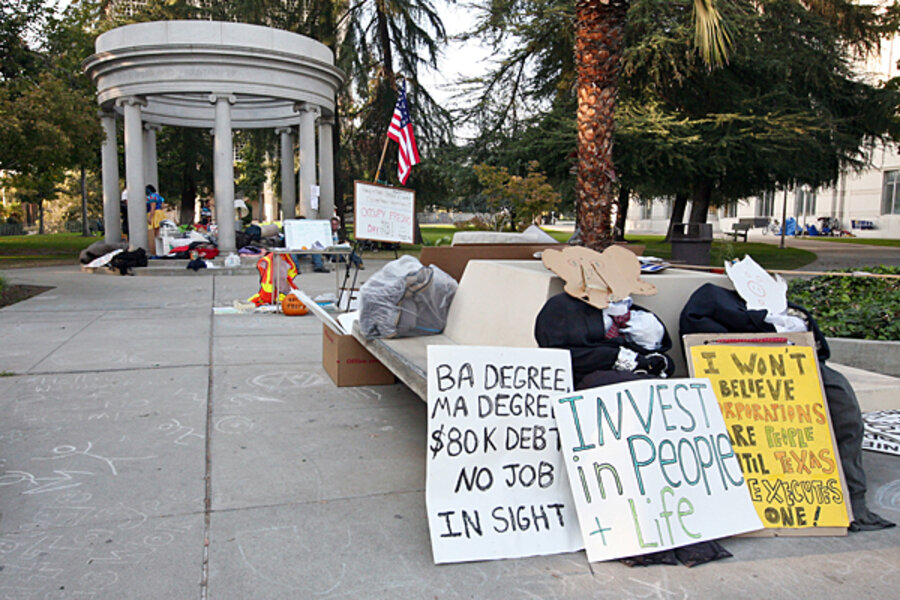Who is Occupy Wall Street? After six weeks, a profile finally emerges.
Loading...
| Los Angeles
The "Occupy Wall Street" signs in New York’s Zuccotti Park may be catchy, but they tell little about the nitty-gritty of the rank and file. Now, six weeks into what is becoming a global movement, pollsters and online data sources have begun to answer some basic questions about participants: What are their political beliefs and who is supporting them?
“We have had a lot of speculation about who these people are,” says Costas Panagopoulos, a professor of political science at Fordham University in New York whose team of 15 researchers surveyed some 300 New York City protesters between Oct. 14 and 18.
“Some of what we found reinforced what many already believed, and some results were surprising,” says Professor Panagopoulos. While 60 percent of protesters said they voted for Barack Obama in 2008, 73 percent said they disapprove of how Mr. Obama is handling his job as president.
Not unexpectedly, given Occupy Wall Street’s assertion that the US political system is adversely affected by an improper distribution of political power, nearly all (97 percent) of those surveyed disapprove of how Congress is handling its job.
[ Video is no longer available. ]
Nevertheless, says Panagopoulos, 42 percent of the protesters said they will vote for the Democratic candidate for the US House for their district. Fewer than 2 percent of those surveyed said they’d vote for the Republican.
“There seems to be a surprising confidence that Democrats will be responsive to their concerns, despite the fact that a Democrat has been in the White House during the past three years as all this has built up,” he says, noting that more than three-quarters (78 percent) believe the economy has gotten worse this past year.
Not surprisingly, perhaps, 75 percent of those surveyed said they view the tea party movement unfavorably, he says.
The average age of the demonstrators, meanwhile, was higher than expected, notes Panagopoulos. “We thought it would be mostly people in their 20s,” he says, but the average age is 33. “That means for every college student you have a mid-career professional in their 40s,” he adds.
Another somewhat surprising aspect of the movement regards its financing. According to the online pay site wepay.com, its donation numbers show that the overwhelming online support comes from “average, middle-class donors,” says wepay.com chief executive officer Bill Clerico.
“The vast majority of those giving have incomes in the $50,000 to $100,000 range,” he says. The median donation amount is $22, while the average rises to $60, which shows that there are a few “very large donations sending the average amount higher,” adds Mr. Clerico. To date, his company has processed more than $325,000 in donations to Occupy Wall Street. Wepay is releasing its latest data on Occupy Wall Street on Tuesday.
The money, he says, comes from 37 countries. The average distance from donor to demonstration for donations given to any campaign is 862.5 miles. “What this shows is that the support really is grass-roots and widespread,” he adds.
However, attempts to pin the demonstrators down may miss the point, says Villanova University Prof. Matthew Kerbel.
“It’s important to remember that OWS is offering an economic critique that doesn’t fit neatly into the red/blue boxes we’re used to using to describe our political debate,” he says. “Their focus on economic inequality indicts both parties for being unduly influenced by the top 1 percent.”
Indeed, adds Brooklyn Law School Prof. Jonathan Askin, quantitative data on the movement may be interesting, but it misses the larger point of the group action.
“The ‘real political opinions’ of the Wall Street Occupiers are largely irrelevant to a consideration of the role that the Occupy Wall Street movement will play in the 2012 elections,” he says via e-mail, adding that Occupy Wall Street is a transformation in the process of civic engagement and political participation.
The movement is a forum to make government “more directly and precisely answerable to the needs of the people,” he says. “Through online social media tools, the people may now monitor and respond to government behavior, and make our elected officials directly answerable to the people, rather than exclusively answerable to the historically more powerful special interests.”





